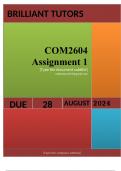BRILLIANT TUTORS
BRILLI
COM2604
Assignment 1
[Type the document subtitle]
tabbymwesh59@gmail.com
DUE 28 AUGUST 2024
[Type the company address]
, Book
Media Studies: Media history, media and society
COM2604 Assignment 1 (COMPLETE ANSWERS) Semester 2 2024) - DUE
21 August 2024 ; 100% TRUSTED Complete, trusted solutions and
explanations.
QUESTION 1 STUDY UNIT 3 Approaches to the study of mass
communication When we attempt to describe, interpret, evaluate and predict a
phenomenon, in this case mass communication, understanding said
phenomenon is key. Various factors influence this. 1.1 In a short paragraph,
present a well-formulated definition of mass communication using your own
examples to substantiate your answer. (5) 1.2 Further to the above, there are
various perspectives on mass communication. Briefly mention each of these
and their specific emphasis. (5) 1.3 The theoretical approach you use also
holds certain implications for your understanding of mass communication.
Briefly discuss the main characteristics of the two approaches listed below:
1.3.1 The technological determinism approach. (5) 1.3.2 The
poststructionalist/postmodern approach. (5) [TOTAL 20]
Question 1: Approaches to the Study of Mass Communication
1.1 Definition of Mass Communication
Mass communication refers to the process of creating, sending, receiving, and analyzing
messages to a large audience through verbal and written media. This includes newspapers,
television, radio, social media, and the internet. For example, when a news broadcast on
television reports on a global event, millions of viewers simultaneously receive the information.
Similarly, a tweet from a popular public figure can be instantly accessed by millions of followers
worldwide.
1.2 Perspectives on Mass Communication
1. Functionalist Perspective:
o Emphasis: Focuses on how mass communication serves the functions of society,
such as information dissemination, entertainment, and cultural transmission.
2. Critical Perspective:
o Emphasis: Analyzes the power dynamics and ideological influences in mass
communication, often critiquing how media perpetuates social inequalities.




